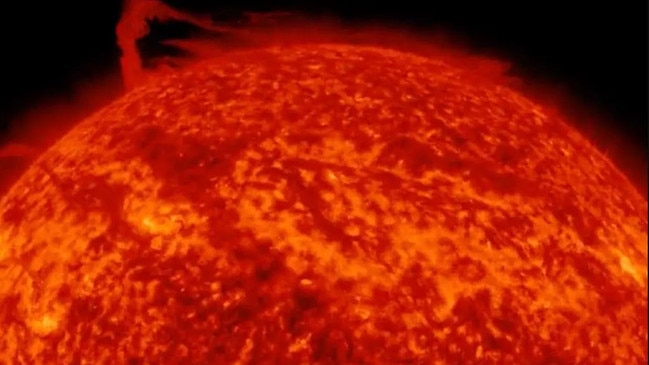Piece of the sun breaks off, stunning scientists: ‘Very curious’
Scientists were left baffled after material broke off of the sun’s surface and created a tornado-like swirl around its northern pole.

Space
Don't miss out on the headlines from Space. Followed categories will be added to My News.
Scientists were left baffled after material broke off of the sun’s surface and created a tornado-like swirl around its northern pole.
The remarkable phenomenon was caught by NASA on the James Webb Space Telescope and tweeted by Dr. Tamitha Skov, a space weather forecaster.
“Talk about Polar Vortex!” she wrote last week. “Material from a northern prominence just broke away from the main filament & is now circulating in a massive polar vortex around the north pole of our Star. Implications for understanding the Sun’s atmospheric dynamics above 55° here cannot be overstated!”

Unusual activity typically occurs at the sun’s 55-degree latitudes once every 11-year solar cycle, according to experts, but this incident is stumping researchers.
A prominence is a large, bright feature that extends outward from the sun’s surface. Other filament tear-aways have been observed in the past — not like this, though.
Solar physicist Scott McIntosh, the deputy director at the National Center for Atmospheric Research in Colorado, told Space.com that researchers aren’t sure what causes such a unique event.
“Once every solar cycle, it forms at the 55-degree latitude and it starts to march up to the solar poles,” McIntosh said. “It’s very curious. There is a big ‘why’ question around it. Why does it only move toward the pole one time and then disappear and then come back, magically, three or four years later in exactly the same region?”

While experts admit it probably has something to do with the sun’s magnetic field, the rest remains a mystery due to humanity’s limited view of its star. Scientists can only view the sun from the “ecliptic plane,” or the geometric plane that contains the orbit of Earth.
The European Space Agency’s Solar Orbiter mission — which is taking photos of the sun while raising its orbit beyond the ecliptic plane — might provide answers, but until then, researchers are left scratching their heads.
Experts have observed solar projections fairly often, such as last year’s solar flares that threatened to impact Earth. Such projections could disrupt GPS systems, power grids, and even radio signals, researchers warned at the time — although there’s no way to precisely predict how this solar vortex would affect our planet.
Just this month, the sun projected multiple “powerful” flares that disrupted communication on Earth, according to Space.com, although it appeared to be otherwise harmless. The sun is en route to reaching its peak of activity during the current 11-year cycle in 2025.
This article was originally published by the New York Post and reproduced with permission
Originally published as Piece of the sun breaks off, stunning scientists: ‘Very curious’




